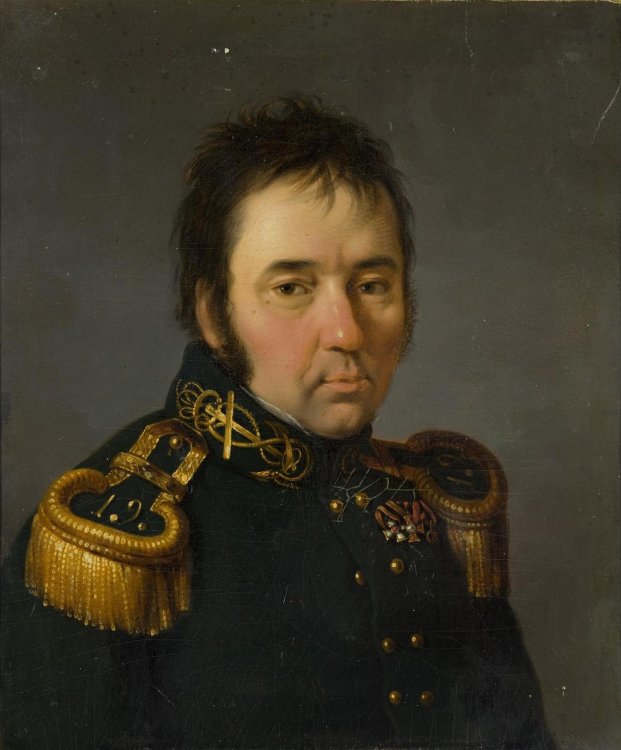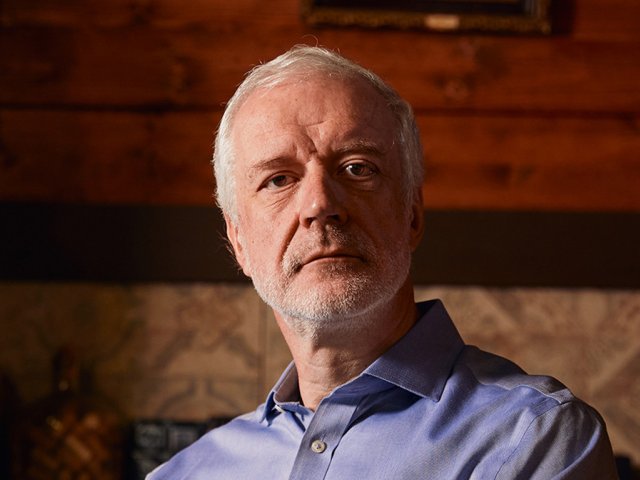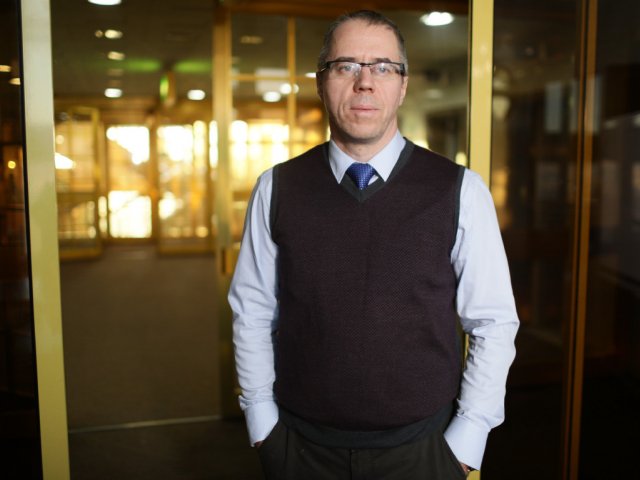Portrait of V. M. Golovnin by Orest Kiprensky
“Needless to say, how little Japan is known in Europe. Although there was a time when the Japanese, having no idea about the greediness of the Europeans, allowed them into their country <...> Therefore, the information about this ancient people should be of interest to educated people. This is what prompted me to inform the world of my adventures as a Japanese captive...”
Vasily Mikhailovich Golovnin was born in 1776 in Ryazan Province to a centuries-old, not very wealthy family. At the age of six, according to common practice – he was already a sergeant in the Preobrazhensky Lifeguard regiment, where his father and grandfather had served. However, the boy soon became an orphan, which led him to the Navy. Serving in the Guards required money, and his guardians decided to send Vasily to the Naval Cadet Corps College.
- On Fire
At the age of 14, not having graduated from the college yet, naval cadet Golovnin enlists on a battleship with the peaceful name Don't Touch Me and takes part in another Russian-Swedish war. As early as that time, he begins to keep his “Notebook” where he describes the main events of his turbulent life in a neat and modest manner. Golovnin does not spread about his heroic deeds, although he takes part in the Battle of Kronstadt and the Battle of Vyborg Bay and receives a medal.
Golovnin was to graduate from the college in 1792, but the 17-year-old veteran was not made a midshipman and was kept “for a second year” because of his young age. Golovnin delves into various sciences, including English language, which was not the most popular language to study at the time. The language of the first maritime nation will come in very handy for him.
A year later Golovnin receives the midshipman's uniform and serves on various vessels of Her Majesty. In 1798, he became a flag officer (direct assistant commandant) in the squadron of Rear Admiral Makarov. Makarov noted the decency and zeal of Lieutenant Golovnin, as well as his linguistic knowledge: “In accordance with his knowledge of the English language, he was employed in the translation of English signals and other matters.”
In 1802, among the twelve best officers, Golovnin is sent to England for training. He finds himself in the fire of confrontation with France, and fights in the waters of the West Indies and the Mediterranean under the pennants of Cornwallis, Collingwood, and Nelson. The legendary one-eyed admiral praised the young officer, something Golovnin, in his habitual manner, omits to mention. Instead, upon his return, he publishes his book The Military Naval Signals for the Daytime and the Nighttime, which the Russian fleet will use for the next 24 years.
- In the Ocean
After serving under the British flag for four years, Golovnin arrives at Kronstadt. A few weeks before him, Krusenstern and Lisyansky returned to the port. Golovnin gets under command his first ship – sloop Diana, which he begins to rebuild from the logging ship. The ship was being prepared to follow up on Krusenstern's success and repeat the circumnavigation of the globe. Never has a ship been entrusted to a lieutenant in the history of the Russian Navy, and never will it be. “Since it was soon necessary to sail beyond the Baltic Sea; however, in deference to Golovnin's experience and knowledge, the Navy Ministry deviated from this general rule,” Admiral Wrangel would later write.
For almost a year Golovnin and his first officer and old friend Pyotr Ricord were selecting the crew and preparing the ship. In July 1807, Diana sets out on a circumnavigation of the globe, which begins with the worst storm in Golovnin's memory. As Diana is sailing toward the Atlantic, English-Russian relationships begin to worsen. Golovnin calls at Portsmouth and seeks permission from the British Crown to conduct an exploratory expedition in the imperial waters. By the end of October, the persistent lieutenant succeeds, and Diana rises anchor.
In April, the sloop rounds the Cape of Good Hope. Golovnin continues to keep his diary, the artistry of which is beyond question: “One can hardly imagine a more splendid picture than the view of this shore, in which it appeared to us. The sky above it was perfectly clear and not a single cloud was visible on the high Table mountain or on the other surrounding mountains. The rays of the sun rising from behind the mountains, pouring a reddish color in the air, portrayed, or, it would be better to say, illuminated all the slopes, steeps, small elevations, and ridges on the tops of the mountains.”
In anticipation of a long-awaited rest, Diana's crew calls at the British port of Simonstone, the home of the British squadron. This is where they discover that Russia and England are already at war. It is difficult to fight against the squadron, and Diana had the prospect of becoming a British prize. The only thing left to rely on was a letter of protection. The document fulfilled its function, but only halfway. The British did not seize the sloop, but they did not let it out of port either.
The Russian sailors found themselves in a strange position. They were not considered prisoners, but they were not ordered to be released until further orders. The British considered it superfluous to supply Diana with provisions. Golovnin spent ten months studying the lifestyle of the natives, exploring the cape, and, drawing hope from its vibrant nature, wrote letters to London. When the stalemate situation became unbearable, he decided to take the sloop out of port. On May 16, 1809, the crew of Diana cut the anchors and broke free.
It is now believed that the British did not obstruct Golovnin deliberately, but he himself made the following record in his diary: “For many circumstances, this day is one of the most critical days of my life.” The story will be described by British maritime writer Patrick O'Brien in his Captain Aubrey adventure saga. There will be no place for this episode, nor for Golovnin, in the Oscar-winning screen adaptation with Russell Crowe, although he will get his share of glory.
In September, Diana reached Kamchatka and finished her voyage, which lasted for 794 days.
- In Captivity
In 1811, Golovnin was ordered to describe the astronomical position of the Shantar and Kuril Islands. During the expedition, Diana docked at Shantar Island (which was Japanese at the time) to replenish provisions. Golovnin and six of his men (two officers and four sailors) went ashore in a dinghy. They also had the Kuril native Alexei with them, who served as an interpreter. This was where the main adventure in Golovnin's career began: all the previous troubles could be called a long prelude. The Russian sailors were taken prisoners for more than two years...
The Japanese were following a “sakoku” — strict policy of self-isolation. Moreover, they were frightened by the pirate activities of Russian ships, known to most readers from the melodramatic rock opera. Five years before Diana, frigate Juno and tender Avos had approached Japanese soil. They had burned down several factories and taken prisoners. The captain of Juno also promised the Japanese a war with Russia, if the Land of the Rising Sun did not open up to interaction with its northern neighbor. Czar punished the officers of the Russian-American Company for their corsair raid, but Golovnin would have to pay the real price for their plunder.
The sailors and the Kuril interpreter were treacherously lured into the fortress, tied up, and sent as far from shore as possible to prevent Diana's crew from rescuing them. This is where Golovnin's deep acquaintance with a culture completely unknown to white people begins: from the ancient art of tying prisoners in a complex system of knots, which he experienced on himself, to the peculiarities of Japanese gastronomy. The Japanese stuck to their well-known politeness and, in their turn, showed great interest in the Russian culture:
“What kind of dress does your monarch wear? What does he wear on his head? (When they learned that Mr. Moore was a good drawer, they asked him to draw the monarch's hat). At what age do women begin to give birth in Russia and at what age do they stop?”
The prisoners would have to talk to a Japanese astronomer and compare the achievements of European and Japanese geometry, as well as stubbornly refuse to describe the Orthodox faith to their researcher-prisoner wardens (the interpreter was no good, and they could not allow any misunderstanding on this issue).
As courteous as the Japanese were, they made it clear that the sailors were not returning from captivity.
“Take one last look at Russia, take one last look at Europe! Now! We are people of another world now. It is not we who have died, it is everything to us that has. We shall never hear anything, never know anything, what is happening in our motherland, what is happening in Europe and in the world! These thoughts tormented my spirit horribly.”
Golovnin understood that the Russian leadership would not abandon its people, but in the event of war, which he already considered inevitable, the likelihood of their release only decreased.
So, the heroes stocked up on provisions, stole two kitchen knives, and magnetized a compass needle by rubbing it against a rock. The plan was to reach the sea and leave for Russia on the first boat they could find. The situation was complicated by the betrayal of one of the officers, who decided to switch to Japanese service:
“He even stopped calling himself Russian (Mr. Moore's father was German in our service, but his mother was Russian, and therefore he was baptized in our faith), and assured the Japanese side that all his kin lived in Germany <...> At that moment we saw that he was the most dangerous man for us and that we should certainly hurry...”
At night, the captives dug a passage and rushed to the sea in the embrace of the mesmerizing Japanese nature. At the very beginning of the journey, Golovnin injured his knee, and soon began to slow his men down:
“... so, I begged them in the name of God to leave me to die alone in the wilderness, but they would never agree to it.”
A week later, despite all their courage and agility, the fugitives were caught. The only hope left was to get help from Russia.
Captain-Lieutenant Ricord, who headed Diana, worked tirelessly. He sends a report to St. Petersburg and sets off on a rescue expedition in 1812. On September 5, Ricord receives terrible news about the death of prisoners. There is one step to the warpath, but the captain does his best to confirm this information.
Three days later, Diana detains a Japanese ship with an influential merchant, Takadaya Kahei, who reports the opposite. The logic of a prisoner exchange, from the viewpoint of samurai values, was unacceptable. Unaware of this, the captain makes the right decision: he releases Takadaya, who will eventually convince the Japanese government to cooperate with the Russians.
Golovnin's two-year captivity comes to an end. The Japanese receive written assurances that the actions of the Juno captain were a private initiative, and the culprits were punished. This is how the history of diplomatic relations between Russia and Japan, which were on the verge of war, began. Thanks to Ricord's flexibility and Takadaya's diplomacy it became a precedent: “Sakoku” had always been strictly complied with and not a single foreigner had ever returned from Japanese captivity.
“In the morning, on the day appointed for our meeting, the interpreters brought to me: one – my hat and the other – my saber, and presented me with the signs of great reverence, congratulating us with unpretentious pleasure.”
Golovnin and his friends, who had been out of touch with the outside world for many months, read the war report with great amazement, understanding that they were trapped in a lost world at the time of the most crucial events for Europe.
- At Liberty
Golovnin returned to St. Petersburg in June 1814: his circumnavigation of the globe lasted seven years. The emperor rewarded the long-suffering sailors with orders and money, and Kuril hunter Alexei was awarded an annual allowance of gunpowder and lead. The crew of Diana, who rescued their comrades, were also awarded.
The notes on Golovnin's adventures were published in 1816 in the Syn Otechestva magazine. They were welcomed with enthusiasm and translated into many European languages. The author revealed a previously unknown civilization to the Western reader. At the same time, a lot of information about Japanese culture is presented not in the form of a reference book, but as an adventure novel. Each line describing Japanese realities, watered with the tears and sweat of the author, is conveyed with his sharp writing talent. Notes of Fleet Captain Golovnin about his Adventures while a Captive of the Japanese is Golovnin's main literary work, his calling card for posterity.
After his release, Golovnin would make one more circumnavigation of the globe and end his bright life with the rank of vice admiral. Yet the most interesting page of his fate is undoubtedly connected with the Land of the Rising Sun. In the Japanese city of Sumoto, there now stands a monument to Russian-Japanese friendship: statues of Captain Golovnin and merchant Takadaya.
Photo on the page: The State Hermitage Museum
Photo on the home page: virtosmedia / Photo bank 123RF






















